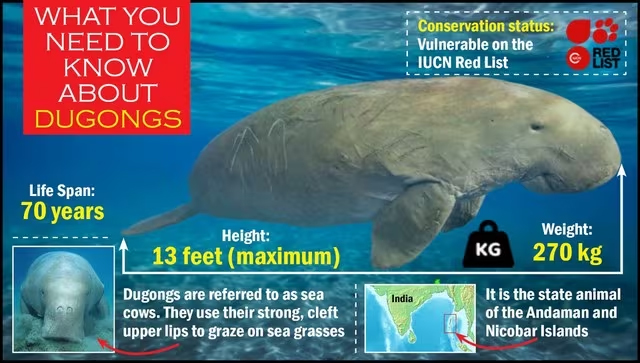Context:
May 28 is celebrated every year as World Dugong Day. Dugongs (Dugong dugon) are the only herbivorous marine mammals in India, inhabiting shallow coastal waters where they feed exclusively on seagrass. Known as “sea cows,” these creatures play a vital ecological role in maintaining seagrass ecosystems.
Key Characteristics:
- Habitat: Coastal waters of the Andaman and Nicobar Islands, Gulf of Mannar, Palk Bay, and Gulf of Kutch.
- Diet: Seagrass species including Cymodocea, Halophila, Thalassia, and Halodule.
- Feeding: Consume 20-30 tonnes of seagrass daily; digest cellulose through specialized horned teeth that are continuously replaced.
- Social Structure: Mostly solitary or in mother-calf pairs; larger groups are rare in India.
- Longevity and Reproduction: Can live up to 70 years; mature at 9-10 years, with calving intervals of 3-5 years, leading to slow population growth (~5% per year).
Significance of Dugongs:
· Seagrass Maintenance: Dugongs graze on seagrass meadows, which helps keep these underwater plants healthy and growing. Healthy seagrass beds:
o Stabilize the seafloor, preventing coastal erosion.
o Improve water quality by filtering pollutants.
o Provide habitat for fish and other marine life that local fishers depend on.
· Supporting Fisheries: Many fish species that live and breed in seagrass beds are a key food source for coastal communities, including farmers who often depend on fish as an important protein supplement.
· Coastal Protection: By maintaining seagrass meadows, dugongs indirectly protect coastal farmlands from erosion and storm surges. Seagrass acts like a natural barrier against waves and flooding.
· Carbon Sequestration: Seagrass beds capture and store carbon, helping mitigate climate change. This benefits farmers by contributing to more stable climate conditions, which are essential for agriculture.
Threats to Dugongs in India:
- Habitat Degradation:
- Loss of seagrass meadows due to coastal development, port construction, and dredging.
- Pollution from agricultural runoff, sewage, and industrial effluents degrading water quality.
- Climate change impacts such as rising sea temperatures and ocean acidification.
- Fishing Practices:
- Shift from non-mechanised to mechanised boats damages seagrass beds.
- Accidental entanglement in gillnets and trawl nets causes mortality.
- Human Activities:
- Increased boat traffic causing injuries and fatalities from collisions.
- Illegal hunting persists despite legal protections under Schedule I species status.
- Population Decline: Current estimates suggest only about 200 individuals remain in Indian waters.
Conservation Efforts:
- Protected Areas:
- India’s first dugong conservation reserve established in Palk Bay, Tamil Nadu, covering 448.3 sq. km with 122.5 sq. km of intact seagrass.
- Research and Monitoring:
- Long-term studies by NGOs and government bodies on dugong populations and seagrass restoration.
- Community Engagement:
- Promoting sustainable fishing methods and alternative livelihoods like dugong-friendly ecotourism.
- Awareness campaigns in coastal villages to report sightings and reduce human-wildlife conflict.
- Policy and Legal Measures:
- India’s commitments under the Convention on Migratory Species and its Memorandum of Understanding on dugong conservation.
Importance of Seagrass Ecosystems:
- Seagrasses stabilize the seafloor, support fisheries, capture carbon, and provide habitat for marine life.
- India hosts over 516 sq. km of seagrass meadows, with the highest diversity found in the Gulf of Mannar and Palk Bay.
- Protecting seagrass is essential not only for dugongs but also for broader marine biodiversity and carbon sequestration.
Conclusion:
Dugongs play a vital role in sustaining healthy coastal ecosystems that support both fisheries and agriculture. Protecting them ensures the well-being of farmers and coastal communities dependent on these natural resources.







